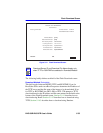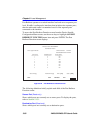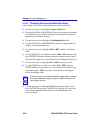
Port Redirect Function Screen
2H23-50R/2H33-37R User’s Guide 5-57
5.15 PORT REDIRECT FUNCTION SCREEN
The Port Redirect Function screen, Figure 5-22, enables the user to set
each Network, Fast Ethernet, or HSIM port as a source or destination
port. A port can be set to have one or more destination ports. For example,
port 1 can be set as a source port with three destinations, ports 2, 3, and 4.
Traffic from port 1 is then automatically redirected to ports 2, 3, and 4.
Port 1 can also serve as a destination port for other ports. Table 5-6 shows
the port organization.
The port redirect function is extremely useful for troubleshooting
purposes, as it allows traffic to be sent to a particular port(s) where, with
the use of an analyzer or RMON probe, all current traffic from the source
port(s) can be examined.
NOTE
The Port Redirect Function screen can only be used if the
operational mode of the device has been set to 802.1D
SWITCHING. Refer to Section 5.7.9, Setting the Operational
Mode, for instructions on configuring the device to operate in
this mode.
Table 5-6 CONN/Port Organization
2H23-50R 2H33-37R
CONN 1 = Network Port 1, 10 Mbps
Network Port 2, 100 Mbps
CONN 1 = Network Port 1, 10 Mbps
Network Port 2, 100 Mbps
CONN 2 = Network Port 3, 10 Mbps
Network Port 4, 100 Mbps
CONN 2 = Network Port 3, 10 Mbps
Network Port 4, 100 Mbps
CONN 3 = Network Port 5, 10 Mbps
Network Port 6, 100 Mbps
CONN 3 = Network Port 5, 10 Mbps
Network Port 6, 100 Mbps
CONN 4 = Network Port 7, 10 Mbps
Network Port 8, 100 Mbps
HSIM = Port 7
Fast Ethernet Slot 5 = Port 9
Fast Ethernet Slot 6 = Port 10
NOTE
Although all traffic from the source port (including, if desired,
errored frames) is sent to the destination port, normal switching
is still performed for all frames on the source port.


















